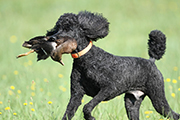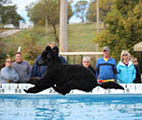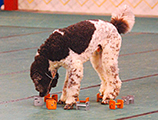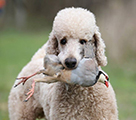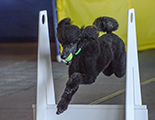
Dedicated to the Health, Education, and Performance of Poodles

Dedicated to the Health, Education, and Performance of Poodles
In order to obtain a Canine Health Information Center (CHIC) number, the Standard Poodle must have completed testing and be registered with the Orthopedic Foundation for Animals (OFA) in the following areas:
Health Elective (One of the following tests):
The above tests are considered the minimum testing required for Standard Poodles that will be used for breeding. Please note that designation with a CHIC number does not show that the dog actually passed the testing, only that the tests were administered.
To check the testing that has been done on a dog, you will need either the dog’s OFA number, the CHIC number, the registration number, or the registered name of the dog. To check the dog’s testing status, go to: https://www.ofa.org/advanced-search.
Many breeders will perform additional testing on their breeding stock. All testing is valuable and gives information regarding the breeder’s interest in the future of his/her breeding program. Using the tools that are currently available will allow the breeder to successfully use the entire gene pool in combinations that provide for a healthy future for the breed.
Note that there is a true difference in types of testing. Very few of our available tests measure genotype (actual DNA sequence of a gene). Most of our tests measure phenotype (a physical evaluation is used to measure the health of an individual in the hope of providing information about genotype). For a variety of reasons, phenotypic testing provides less reliable information about the genes a given dog might pass on to offspring. For a full explanation of the interpretation and use of phenotype testing, see the article found on the Tufts web site: https://www.vin.com/apputil/content/defaultadv1.aspx?meta=Generic&pId=11165&id=3848681
Poodles may have eye abnormalities which include progressive retinal atrophy (PRA), optic nerve hypoplasia, distichiasis, micropapilla, and microphthalmia. PRA is considered hereditary, and some other eye abnormalities are presumed to be hereditary. Many of these abnormalities lead to blindness, although some can be corrected with surgery. For more information see: https://www.ofa.org/diseases/eye-certification/eye-disease-glossary.
The Companion Animal Eye Registry (CAER) exam is an eye screen performed by a board certified veterinary ophthalmologist.
The CAER eye exam is performed after drops are placed in the eyes to dilate the pupils. The exam is not comprehensive, but rather intended to detect a number of eye defects presumed to be hereditary. If a serious ocular health problem such as glaucoma is suspected, the examiner will recommend a more comprehensive examination. The diagnoses obtained during the exam refer only to the observable phenotype (clinical appearance) of an animal. Thus it is possible for a clinically normal animal (normal phenotype) to have a genetic abnormality (abnormal genotype) that may result in a clinically detectable eye disorder later in life. For this reason it is important to repeat CAER exams on a regular schedule (yearly is recommended) for breeding animals, even after they are no longer being bred.
The CAER eye screen may be done at eight weeks.
The CAER eye screen is done by a Board Certified ophthalmologist at his office or at an eye clinic held in your area sponsored by a breed club.
Hip dysplasia is an inherited polygenetic disease that manifests itself in a malformation of the hip joint in which the ball and socket do not properly fit together. Mildly dysplastic dogs may not exhibit any outward signs. Moderate to severe cases may exhibit rear-end lameness and/or discomfort when getting up. Arthritis often occurs over time from wearing on the hip joint. Young dogs, five to ten months, may be affected, and older dogs may develop chronic degenerative joint disease. For more information see: https://www.ofa.org/diseases/hip-dysplasia.
X-ray.
At 24+ months for OFA hip certification, at 16+ weeks for PennHIP scores (although a more accurate score may be obtained at six months, or even twelve months).
Many veterinarians are experienced in x-raying dogs’ hips. These films are sent to the OFA registry for a reading. Only PennHIP certified orthopedic and radiological specialists can do the PennHIP films; however, all PennHIP results can be sent to, and certified by, OFA.
In Standard Poodles, atrial septal defect (ASD) and patent ductus arteriosis (PDA) are inherited defects of the heart which can lead to a shortened life span and impaired quality of life. For more information see: https://www.ofa.org/diseases/other-diseases/cardiac-disease.
Doppler echocardiograph.
For certification, this test should be performed on dogs who are at least twelve months of age, or older. However, younger dogs and puppies may have preliminary evaluations.
It is recommended that a veterinarian board certified in clinical cardiology perform this test. Other veterinarians with the training and equipment may be able to perform the test.
Either a Congenital Cardiac Exam or an Advanced Cardiac Exam is one of four tests available to fulfill the health elective to obtain a CHIC number in Standard Poodles.
Sebaceous adenitis (SA) is a hereditary skin disease in which the sebaceous glands become inflamed, often leading to progressive loss of hair. The disease is primarily seen in Standard Poodles, Akitas and Samoyeds, although there have been reported cases in a number of other breeds as well as mixed breeds. The disease can develop during a wide age range, with age of onset documented as early as one year and as late as twelve years. For more information, see: https://www.ofa.org/diseases/other-diseases/sebaceous-adenitis.
A minimum of two small skin biopsies are taken from the top of the head down the midline near the shoulders if there are no clinical signs of SA. If there is hair loss and scaling on the dog, the biopsies are taken from the affected areas.
After the second birthday and annually thereafter for dogs in a breeding program.
Your veterinarian can take the biopsies. These are then sent to a certified veterinary dermatopathologist. For a list of the currently certified dermatopathologists, go to CHIC pages at: https://www.ofa.org/diseases/other-diseases/sebaceous-adenitis.
An OFA SA evaluation is one of four tests available to fulfill the health elective to obtain a CHIC number in Standard Poodles.
The most common cause of primary hypothyroidism (underactive thyroid) in dogs is autoimmune thyroiditis. Autoimmune thyroiditis is a heritable disease that is seen in all three varieties of Poodles, but is more common in Standard Poodles. This disorder may affect a dog at any age, but clinical signs are often seen in dogs between two to five years of age. Hypothyroidism is not generally a life-threatening disease, but it is a permanent condition. When diagnosed, the traditional, effective treatment is a daily, or twice daily, dose of a thyroid hormone replacement (synthetic L-thyroxine). Dogs with this condition should not be bred. Breeding animals should be tested yearly for the first four years and, after that, every other year. For more information, see: https://www.ofa.org/diseases/other-diseases/hypothyroidism
Blood sample.
Subsequent to sexual maturity in males, and between heat cycles (twelve to sixteen weeks following onset of heat) in females.
Thyroid testing is difficult to do correctly so only a few laboratories are recognized by the OFA. For a list of recognized laboratories, go to the OFA website at https://www.ofa.org/diseases/other-diseases/hypothyroidism/thyroid-labs.
An OFA Thyroid evaluation is one of four tests available to fulfill the health elective to obtain a CHIC number in Standard Poodles.
Failure of the adrenal glands to secrete the corticosteroid hormones. In primary Addison’s, this is usually due to autoimmune damage to the adrenal cortex. Initial symptoms are vague and may include depression, lack of appetite, vomiting and/or diarrhea with abdominal pain and muscle weakness. In an acute crisis, symptoms include low blood pressure with weakness, shivering and impaired kidney function. For more information see: http://www.vetmed.wsu.edu/outreach/Pet-Health-Topics/categories/diseases/addison’s-disease.
Addison’s e-mail list groups: http://www.k9addisons.com/subscribe.html
Or write: AddisonDogs_-subscribe@yahoogroups.com
Also see: http://www.addisondogs.com/support/
Blood tests will usually show the following: cortisol level determination (low); CBC (complete blood count) in which certain white blood cells occur in higher than normal numbers; and an abnormal (low) ratio of sodium to potassium. A definitive diagnosis of Addison’s is by an ACTH stimulation test. At this writing there is no DNA test to search for carriers of this disease and no way to determine if a dog will get Addison’s disease until the dog is actually ill with the disease.
Testing is done if a screening blood test and symptoms indicate the possibility of Addison’s disease.
Most veterinarians can do these tests and send them to a laboratory for analysis.
A negative result on an ACTH stimulation test only means the dog does not have Addison’s disease at that point in time. There is no guarantee that the dog will not be affected later in his/her life.
DM is a progressive disease of the spinal cord and has a typical onset between the ages of eight and fourteen years. Clinical signs of the disease may include dragging the rear feet, wobbling when walking, or falling over. The dog may find it difficult to stand and may eventually have no use of the rear legs. Unfortunately, there is not a cure for the disease, nor are there treatments to slow the progression of DM. DM does not cause pain to the dog. Please note that there is a low incidence of DM in Standard Poodles at this writing. It is advisable, however, to have breeding animals tested and to consider their DM status as one factor in making breeding decisions. For more information on the use of the DM test in a breeding program see: http://www.caninegeneticdiseases.net/DM/testDM.htm.
DNA test using a cheek swab.
Anytime after a dog is three to four weeks old.
The DNA test is available from OFA at https://www.ofa.org/diseases/dna-tested-diseases/dm and will identify clear dogs (those that have two normal copies of the gene), carrier dogs (those that have one normal and one abnormal copy of the gene), and genetically affected dogs (those that carry two abnormal copies of the gene). Genetically affected dogs are at risk to develop the disease at some point as they age. Clear and carrier dogs are very unlikely to develop DM. Research is currently underway to determine why the age of onset of clinical disease varies in affected dogs and why some genetically affected dogs never develop DM.
Poodles may have eye abnormalities which include progressive retinal atrophy (PRA), optic nerve hypoplasia, distichiasis, micropapilla, and microphthalmia. PRA is considered hereditary, and some other eye abnormalities are presumed to be hereditary. Many of these abnormalities lead to blindness, although some can be corrected with surgery. For more information see: https://www.ofa.org/diseases/eye-certification/eye-disease-glossary.
The prcd-PRA test is done on a small sample of blood, or from a cheek swab. The test analyzes the specific DNA mutation causing prcd-PRA, the most common form of PRA. The test detects the mutant gene copy and the normal gene copy. The result of the test is a genotype and allows separation of dogs into three groups: normal/clear (homozygous normal), carrier (heterozygous) and affected (homozygous mutant). Affected or carrier status must be bred only with normal/clear to produce non-affected offspring. For more information, go to OptiGen’s website at http://www.optigen.com/opt9_test_pra_poodle.html. Although the predominant form of PRA in Poodles is prcd-PRA, another form of PRA occurs at much lower frequencies. Information on rcd4-PRA can be found at http://vipoodle.org/health_testing_items/eyes-rcd4-pra/
Various labs have collection protocol that should be followed for that lab.
DNA tests can be done as soon as the lab will accept using their protocol. Some lab will accept dew claws or docked tails. Cheek swabs may be obtained as soon as the risk of contamination from other nursing puppies can be alleviated.
We recommend that owners/breeders use laboratories to submit testing for prcd-PRA that are approved by OFA and to record their results with OFA. A list of those labs may be found https://www.ofa.org/dna-test-labs
This is a genotype exam.
Poodles may have eye abnormalities which include progressive retinal atrophy (PRA), optic nerve hypoplasia, distichiasis, micropapilla, and microphthalmia. PRA is considered hereditary, and some other eye abnormalities are presumed to be hereditary. Many of these abnormalities lead to blindness, although some can be corrected with surgery. For more information see: https://www.ofa.org/diseases/eye-certification/eye-disease-glossary.
The rcd4-PRA test is done on a small sample of blood, or from a cheek swab. The test analyzes the specific DNA mutation causing rcd4-PRA. The test detects the mutant gene copy and the normal gene copy. The result of the test is a genotype and allows separation of dogs into three groups: normal/clear (homozygous normal), carrier (heterozygous) and affected (homozygous mutant). Affected or carrier status must be bred only with normal/clear to produce non-affected offspring. For more information, go to http://www.optigen.com/opt9_rcd4PRA.html.
Another form of PRA occurs at much higher frequencies. Information on prcd-PRA can be found at http://vipoodle.org/chic_testing_items/eyes-prcd-pra/
Various labs have collection protocol that should be followed for that lab.
DNA tests can be done as soon as the lab will accept using their protocol. Some lab will accept dew claws or docked tails. Cheek swabs may be obtained as soon as the risk of contamination from other nursing puppies can be alleviated.
We recommend that owners/breeders use laboratories to submit testing for rcd4-PRA that are approved by OFA and to record their results with OFA. A list of those labs may be found https://www.ofa.org/dna-test-labs.
This is a genotype exam.
Elbow dysplasia is a general term used to identify an inherited polygenic disease in the elbows of dogs. Young dogs, four to ten months of age, may begin to show lameness. The elbows may seem swollen and are held outward from the chest. For more information, see: https://www.ofa.org/diseases/elbow-dysplasia.
X-ray.
At 24+ months for OFA certification.
Many veterinarians are experienced in x-raying dogs’ elbows. These films are sent to the OFA registry for a reading.
“Neonatal” refers to the time immediately after birth. “Encephalopathy” refers to a disease affecting the brain. Thus, neonatal encephalopathy means a disease of the brain that becomes apparent soon after pups are born. Affected pups are weak, uncoordinated, and mentally dull from birth. If they survive the first few days, they nurse adequately. However, they may not be able to compete with stronger pups in the litter and their growth may be stunted. Some cannot stand at all. Others manage to struggle to their feet and walk with jerky movements, falling frequently. Seizures develop in most affected pups at four to five weeks of age. Attempts to control these seizures with medication have proven futile, and the pups die or are euthanized before they reach weaning age. For more information, see: http://www.caninegeneticdiseases.net/ataxia/NE-StdP.htm.
DNA test using a cheek swab.
Anytime after birth.
The DNA test is available from the Orthopedic Foundation for Animals (OFA) https://www.ofa.org/diseases/dna-tested-diseases/neonatal-encephalopathy-with-seizures.
Von Willebrand’s disease is an inherited bleeding disorder. In vWD, bleeding is caused by the absence of the von Willebrand’s factor which is needed in the early stages of clotting. For more information see: http://www.vetgen.com/canine-vwd1.html.
DNA test using a cheek swab.
Anytime after birth. If both parents are certified clear and if the parents are certified by the lab as being the parents of the litter, then a “certificate by pedigree” may be issued to the offspring.
Test kits are available from VetGen. See the contact information for VetGen in the address section.
The information contained in these documents is current at the time of this writing and is accurate to the best of VIP’s knowledge.



